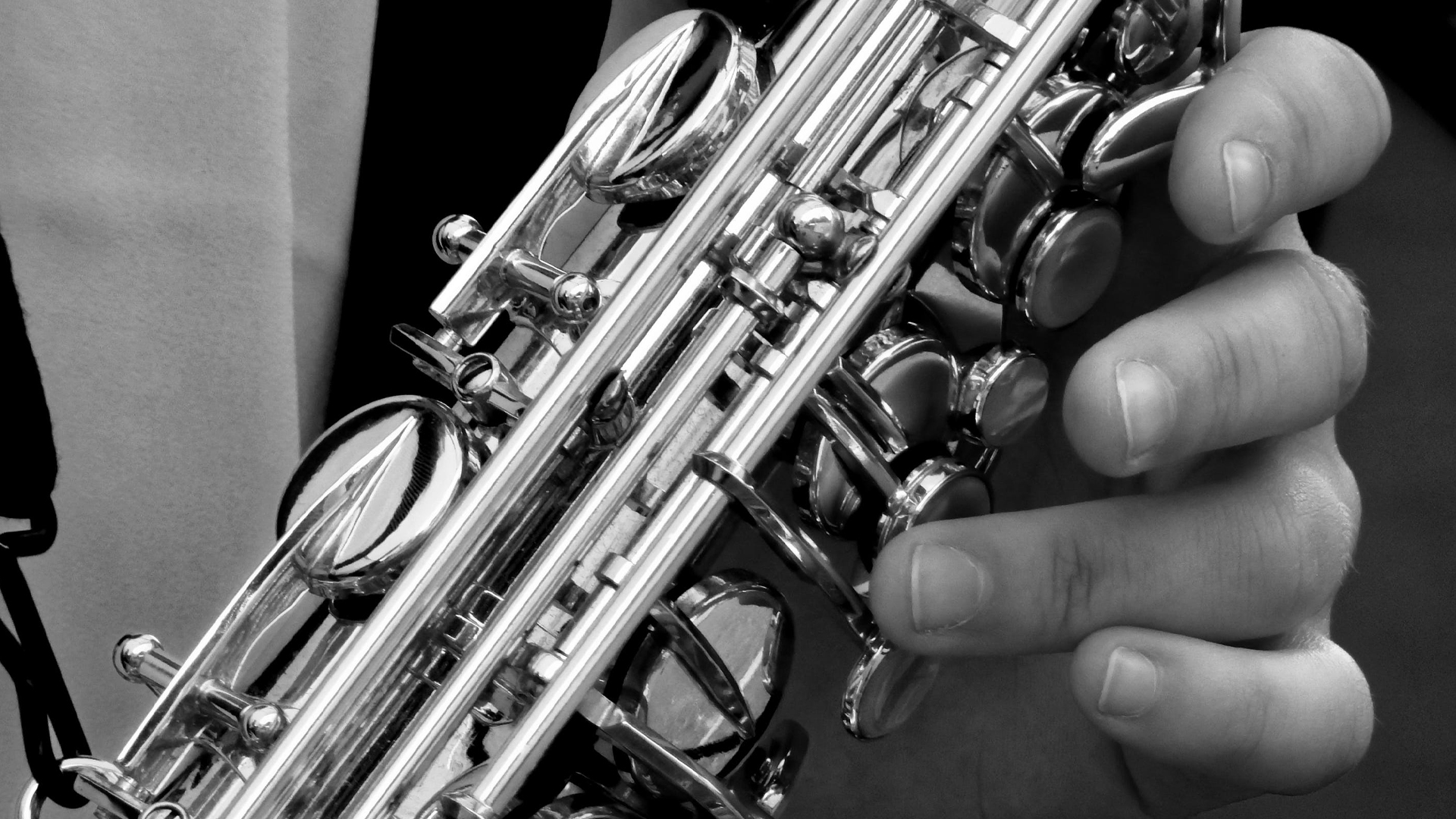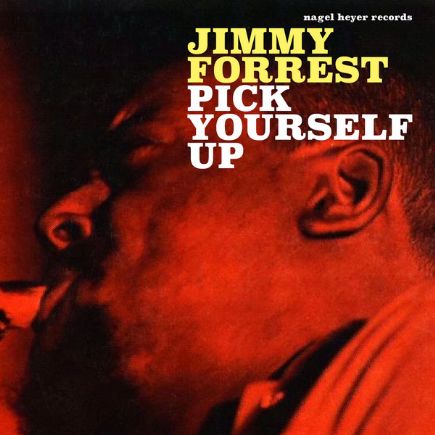Jimmy Forrest, un souffle de soul dans le jazz
Saxophoniste ténor au son puissant et chaleureux, Jimmy Forrest occupe une place singulière dans le paysage du jazz américain. S’il n’a jamais recherché les feux de la rampe, il a su, par sa constance stylistique et son expressivité directe, incarner une tradition vivante du jazz, nourrie à la fois par le swing, le rhythm and blues et les racines du blues.
Né à Saint-Louis, ville marquée par la vitalité des musiques afro-américaines, Jimmy Forrest débute sa carrière dans les big bands des années 1940. Il joue notamment avec Fate Marable, Jay McShann, Andy Kirk, puis rejoint l’orchestre de Duke Ellington en 1948, où il côtoie des figures majeures telles que Johnny Hodges ou Harry Carney. C’est dans cet écrin orchestré avec raffinement qu’il développe un phrasé robuste, souple et chargé de feeling.
En 1951, il connaît un succès national inattendu avec Night Train, un riff lancinant et hypnotique basé sur un thème popularisé par Ellington et orchestré avec une efficacité redoutable, qui a atteint la première place du classement Billboard R&B en mars 1952, et est resté au sommet pendant sept semaines. Ce morceau devient un classique du rhythm and blues instrumental et reste aujourd’hui son enregistrement le plus célèbre. Derrière sa simplicité apparente, Night Train révèle l’essence même de l’art de Forrest: un sens inné du groove, un lyrisme contenu, une expressivité sans afféterie.
Tout au long des années 1950 et 1960, Jimmy Forrest enregistre plusieurs albums en leader, notamment pour les labels Prestige et Delmark, souvent en formation resserrée, avec des musiciens comme Grant Green, Miles Davis (à ses débuts), Harold Mabern ou Elvin Jones. Il se distingue par sa capacité à passer sans rupture du swing au hard bop, du blues urbain au jazz soul, tout en conservant une identité sonore reconnaissable.
Dans les années 1970, il participe à de nombreux projets aux côtés du trompettiste Harry ‘Sweets’ Edison et réapparaît dans des formations de jazz mainstream, où sa sonorité profonde et narrative reste très appréciée. Malgré une carrière relativement discrète, Jimmy Forrest incarne un chaînon essentiel entre les grandes heures du big band, le R&B instrumental et les hybridations du jazz moderne.
Jimmy Forrest, un soplo de soul en el jazz
Saxofonista tenor de sonido potente y cálido, Jimmy Forrest ocupa un lugar singular en el panorama del jazz estadounidense. Aunque nunca buscó el centro de la escena, supo, gracias a su coherencia estilística y su expresividad directa, encarnar una tradición viva del jazz, alimentada por el swing, el rhythm and blues y las raíces del blues.
Nacido en San Luis, ciudad marcada por la vitalidad de las músicas afroamericanas, Forrest comenzó su carrera en las big bands de los años cuarenta. Tocó con figuras como Fate Marable, Jay McShann y Andy Kirk, y en 1948 se incorporó a la orquesta de Duke Ellington, donde compartió escenario con nombres fundamentales como Johnny Hodges o Harry Carney. En ese contexto refinado desarrolló un fraseo robusto, flexible y cargado de sentimiento.
En 1951 alcanzó un inesperado éxito nacional con Night Train, un riff hipnótico y envolvente basado en un tema popularizado por Ellington y orquestado con notable eficacia. El tema alcanzó el primer puesto del ranking Billboard R&B en marzo de 1952 y se mantuvo allí durante siete semanas. Convertido en un clásico del rhythm and blues instrumental, sigue siendo su grabación más célebre. Bajo su aparente sencillez, Night Train condensa la esencia del arte de Forrest: un sentido innato del groove, lirismo contenido y una expresividad sin afectación.
Durante las décadas de 1950 y 1960, Forrest grabó varios discos como líder, sobre todo para los sellos Prestige y Delmark, a menudo en formaciones reducidas con músicos como Grant Green, un joven Miles Davis, Harold Mabern o Elvin Jones. Destacó por su capacidad para pasar sin esfuerzo del swing al hard bop, del blues urbano al jazz soul, sin perder una identidad sonora propia.
En los años setenta participó en numerosos proyectos junto al trompetista Harry ‘Sweets’ Edison y reapareció en formaciones de jazz mainstream, donde su sonido profundo y narrativo siguió siendo muy valorado. A pesar de una carrera relativamente discreta, Jimmy Forrest representa un eslabón esencial entre la era dorada de las big bands, el R&B instrumental y las hibridaciones del jazz moderno.
Jimmy Forrest, un soffio di soul nel jazz
Sassofonista tenore dal suono potente e avvolgente, Jimmy Forrest occupa una posizione singolare nel panorama del jazz americano. Pur senza cercare mai i riflettori, ha saputo incarnare, grazie alla coerenza stilistica e a un’espressività diretta, una tradizione viva del jazz, nutrita di swing, rhythm and blues e radici blues.
Nato a Saint Louis, città impregnata della ricchezza delle musiche afroamericane, Forrest iniziò la sua carriera nelle big band degli anni Quaranta. Suonò con Fate Marable, Jay McShann, Andy Kirk e, nel 1948, entrò nell’orchestra di Duke Ellington, accanto a figure leggendarie come Johnny Hodges e Harry Carney. In questo ambiente orchestrale raffinato sviluppò un fraseggio solido, flessibile e carico di sentimento.
Nel 1951 ottenne un inaspettato successo nazionale con Night Train, un riff ipnotico e insistente basato su un tema reso celebre da Ellington e arrangiato con efficacia straordinaria. Il brano raggiunse il primo posto della classifica Billboard R&B nel marzo 1952, rimanendovi per sette settimane. Divenuto un classico del rhythm and blues strumentale, è tuttora la sua incisione più celebre. Dietro la sua apparente semplicità, Night Train rivela l’essenza dell’arte di Forrest: groove naturale, lirismo trattenuto, espressività autentica e priva di artifici.
Negli anni Cinquanta e Sessanta Forrest registrò numerosi album da leader, soprattutto per le etichette Prestige e Delmark, spesso in piccoli gruppi con musicisti come Grant Green, un giovane Miles Davis, Harold Mabern o Elvin Jones. Si distinse per la capacità di passare senza soluzione di continuità dallo swing al hard bop, dal blues urbano al soul jazz, mantenendo sempre una voce musicale riconoscibile.
Negli anni Settanta partecipò a molti progetti al fianco del trombettista Harry ‘Sweets’ Edison e tornò a esibirsi in formazioni di jazz mainstream, dove il suo suono profondo e narrativo era ancora molto apprezzato. Nonostante una carriera relativamente riservata, Jimmy Forrest rappresenta un anello essenziale tra l’età d’oro delle big band, il R&B strumentale e le contaminazioni del jazz moderno.
Jimmy Forrest, a soulful breath in jazz
A tenor saxophonist with a powerful and warm tone, Jimmy Forrest holds a unique place in the American jazz landscape. Though he never sought the spotlight, his stylistic consistency and direct expressiveness allowed him to embody a living jazz tradition rooted in swing, rhythm and blues, and deep blues influences.
Born in St. Louis, a city rich in African American musical heritage, Forrest began his career in the 1940s big band scene. He played with Fate Marable, Jay McShann, and Andy Kirk, and in 1948 joined Duke Ellington’s orchestra, where he shared the stage with jazz giants such as Johnny Hodges and Harry Carney. Within that refined orchestral setting, he developed a robust, supple, and soulful phrasing.
In 1951, Forrest achieved unexpected national fame with Night Train, a hypnotic, riff-based tune derived from a theme popularized by Ellington and arranged with striking efficiency. The track reached No. 1 on the Billboard R&B chart in March 1952 and stayed at the top for seven weeks. It became a landmark instrumental in rhythm and blues and remains his most iconic recording. Beneath its apparent simplicity, Night Train captures the essence of Forrest’s art: a natural sense of groove, restrained lyricism, and expressive depth free of pretension.
Throughout the 1950s and 1960s, Forrest recorded several albums as a leader, notably for the Prestige and Delmark labels, often in small group settings with musicians like Grant Green, a young Miles Davis, Harold Mabern, and Elvin Jones. He was known for his fluid ability to move from swing to hard bop, from urban blues to soul jazz, while maintaining a distinctive sonic identity.
In the 1970s, he took part in numerous projects alongside trumpeter Harry ‘Sweets’ Edison and reemerged in mainstream jazz circles, where his deep, storytelling tone remained highly valued. Despite a relatively low-profile career, Jimmy Forrest represents a crucial link between the golden era of big bands, instrumental R&B, and the evolving hybrid forms of modern jazz.


